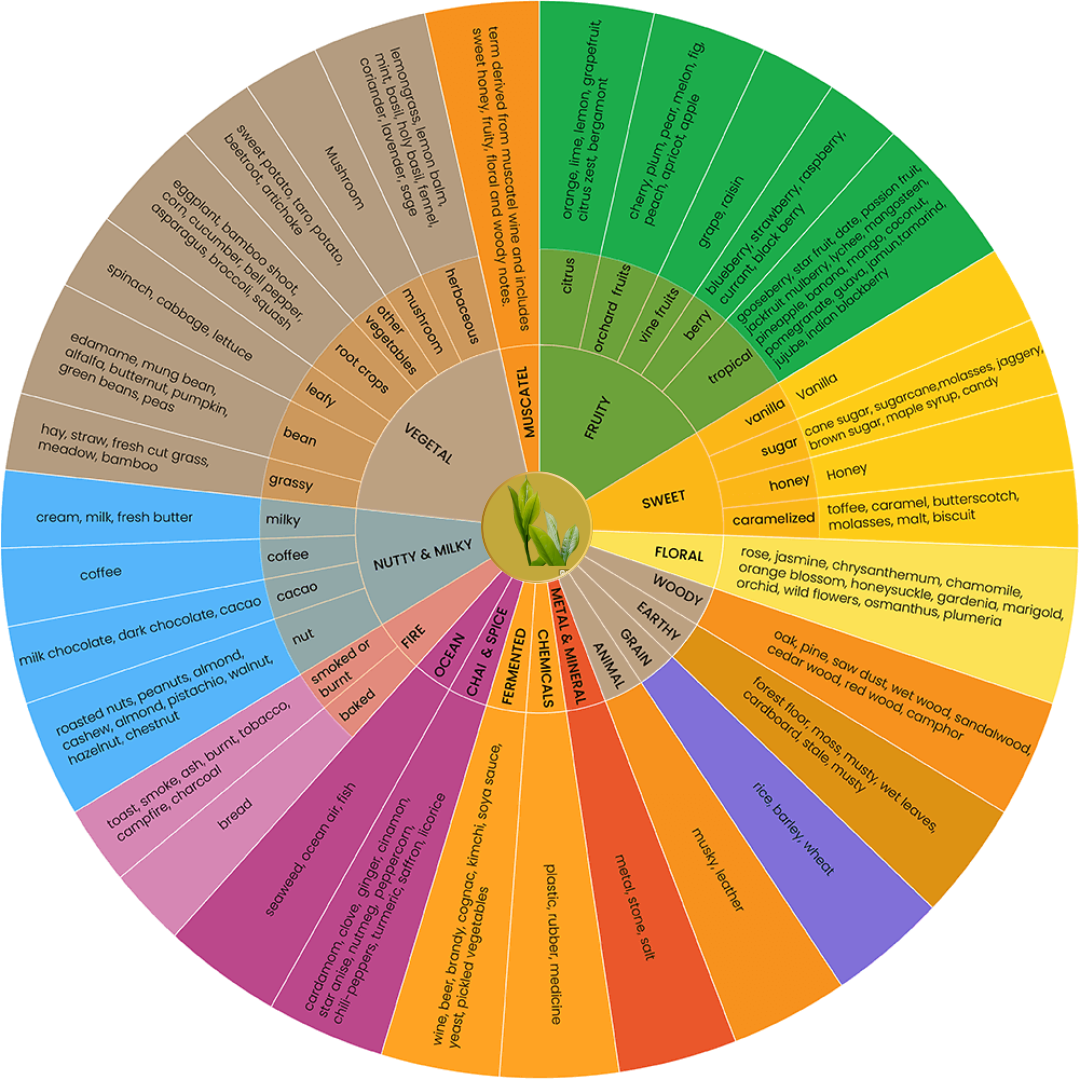
Tasting tea is an adventure on its own, but the Wheel of Tea takes it one step further. This diagram, which is also referred to as Tea Flavour Wheel or Aroma Wheel, assists you in recognizing the various flavours and scents in each cup of tea. At first, it might seem overwhelming, but in reality, with a little practice it becomes easy to identify flavors and have a more profound appreciation for tea.
The structure of Wheel of Tea functions as a map. The middle contains broader flavor family groups, for instance, floral, fruity, and earthy. As you move away from the center, these groups get further divided into more specific terms, similar to chapters in a book. Enhancing your understanding of tea is just one of the benefits of using the wheel; after a while, “you” will be able to identify and appreciate flavors that were hitherto ignored.
When sipping tea, it is common to observe floral notes of jasmine or rose. These teas are gentle,sweet, and soft. Fruity profiles are more energetic, and include spices like citrus, berries, and tropical fruits. Earthy profile includes pu-erh tea, which has a hint of damp soil. Chai is an example of spiced tea and is warm and includes cinnamon, cardamom, and ginger. Every category introduces a whole new spectrum of tasting possibilities.
Employing the Tea Flavor Wheel is a straightforward task. Start by selecting a high-quality tea and pay attention to the details while brewing. Notice the color and clarity. Take a deep breath to feel the aroma. Sip it and feel the tea rest on your tongue. Identify the most dominant flavor using the wheel and then trace the secondary notes in the outer rings. It is similar to piecing together an intricate puzzle of flavors.
Each type of tea has its distinct signature aromas. The scent of green teas is mostly fresh and grassy, and occasionally nutty or even marine-like. You can find malty, fruity, or even smoky aromas in black teas. Oolongs can be nutty and roasted or fresh and floral, while white teas exhibit livestock scents of hay or honey. Earthy with the slightest hint of damp wood or mushrooms underscores pu-erh teas, while herbal teas invigorate with sweet, minty, or fruity notes.
Tea’s smell and taste depends on multiple factors. The selection of the tea variety matters a lot; some cultivars are sweet while others are more full-bodied. The complexity of tea also depends on the growing conditions such as altitude or soil type. The profile of the tea is shaped by the processing methods of oxidation, rolling, and firing. Even brewing methods like steeping time and water temperature have a huge impact.
The sense of aroma is vital in tea tasting. Smelling the tea allows one to appreciate the more delicate undertones that taste buds may not fully capture. The appreciation of tea’s fragrance requires a comfortable space with gentle warmth. The user has to inhale deeply by bringing the nose closer to the mug after it has been warmed, as well as swirl the tea in order to observe how the cooling of the tea alters the fragrance. This practice serves to enhance perception and strengthen the bond with the tea.
Embarking on a tea tasting journey can be a joyful task. The user should start with some of the most famous teas such as black, green, oolong, white, and pu-erh. Make sure to use the wheel of tea in order to scent and flavor map them. To further deepen the understanding of tea, feel free to enroll with professionals. Carrying a journal to document the personal preferences as well as the experiences will be quite useful. The collection of tea experiences will eventually refine the user’s taste buds and change their perception towards different types of tea.
Trying out different brewing methods can be quite an interesting challenge. Many new flavors can be uncovered with different steeping times as well as water temperatures. Taking the time to steep different types of tea can help showcase their underlying flavors. Using the most basic methods like bowl brewing alongside quality tools such as an aroma cup or gaiwan can bring about an new experience.
Drinking tea is not as simple as sipping it; tea tasting is an experience filled with traditions, nature, and an entire cup of history. History has given us instruments and the Tea Aroma Wheel is one of its masterpieces, guiding us through the sensational experience. Getting to know new tea types, riding their aromas, or steeping them into new concoctions, all of these are simple but fun experience that will change your taste over time. The best part? The world is filled with adventures and the wonders of tea, ready for exploration, so pour yourself a cup, take a deep breath, and let the real adventures begin.
Meet the Writer

[Bhaskar Dahal]
[Bhaskar Dahal is a second generation tea entrepreneur and founder of Nepal Hills Tea Inc, a Canada based Tea company.]



